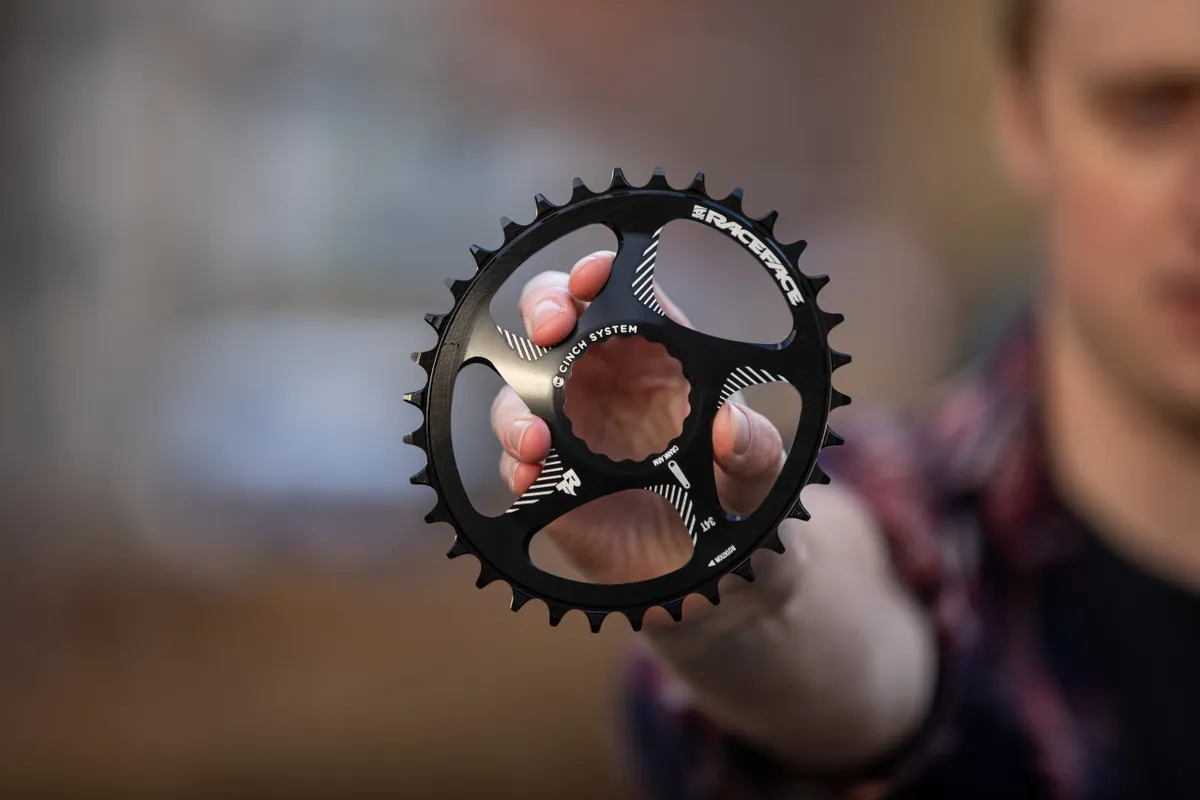Chainrings are probably the least glamorous component in a drivetrain, but upgrading to a smaller one is something everyone should do.
While cassette ratios are relatively fixed – most 12-speed drivetrains use 10-51t or 10-52t ranges (or thereabouts) – the chainring is the quickest, easiest and best way to fine-tune your drivetrain's feel.
Generally, bikes come fitted with a 32t chainring from the factory, and SRAM's retail Eagle Transmission drivetrains are also supplied with 32t rings. In my opinion, that makes the easiest and hardest gear ratios just too high.
OK, I'll concede smaller chainrings are available. SRAM's offerings go down to 30t, while Shimano's start at 28t. But the point stands. The bike you buy off the shelf will almost always be fitted with a chainring that's just not low enough. You're probably grinding away in a gear that's too hard when you really don't need to.
Impossibly steep climbs

A small chainring is great for tackling impossibly steep climbs.
When gradients reach 15 per cent and higher, having the option to click into an even lower cog is welcome. Spinning at 80 to 90rpm reduces the horrible, grinding feeling lower cadences and higher ratios can send through your knees. The sensation of pulverising your joint's cartilage as your legs spin is something we all want to avoid – or at least minimise.
But there's more to it than winching comfortably up the steepest climbs you can find. Leaving headroom in your bike's drivetrain on more 'normal' terrain means you've got the option to use the 'bailout gear' (which 50-plus tooth cassette sprockets were once called) when you bonk, or if you just want to ride a bit slower.

Now I've got a 28t chainring fitted, I frequently find myself riding around in gear four, five or six when my friends with 32t rings will be in gears one, two or three.
Once I'm tired towards the end of a ride or want to recover between descents while climbing, I can select an easier gear and still have even lower ratios left over if the gradient steepens.
Being able to spin rather than grind is bliss.
The other end of the cassette

But some may argue I've limited my top speed potential by lowering my highest gear.
That may be true if your name is Evie Richards, Richie Rude, Hattie Harnden or any other high-power-producing pro. But, as a humble amateur cyclist, I don't buy it as an argument for running a bigger ring.
In practical real-life conditions – such as downhill, off-road, when it really matters – I've never managed to spin out in my hardest, highest gear (28t chainring, 10t cassette sprocket).
And speed doesn't just come down to how hard you're pedalling. When you're travelling at over 25mph, unless you're bombing down a smooth fireroad, how much extra forward drive are you adding by mashing the pedals on proper terrain compared to pumping to gain valuable miles per hour?
I'll go out on a limb and say absolutely none.
Compatibility issues?

It's relatively pain- and problem-free to fit a smaller chainring.
The standard rules apply: make sure you select the correct tooth profile for your chain; pick the right mounting pattern for your cranks; and make sure there's ample clearance between the chainstay and chain.
Being picky, a smaller ring than the one your bike was designed for will increase anti-squat, reducing pedal bob but increasing pedal kickback. In reality, the difference in physical size between a 32t and 28t chainring is minimal – and it's unlikely to cause masses of extra feedback when you're descending.
In my experience, none of these things has been a big enough problem to outweigh the advantages of spinning rather than grinding.
Alternative options

Oval chainrings are a potential alternative to reducing the teeth count of a standard round one.
These are designed to 'smooth' out your power output as you pedal, increasing resistance during the 'strong' part of your pedalling stroke and reducing it at the 'weaker' part.
However, the number of teeth the chainring has will dictate your cadence – the smaller the ring, the higher the potential cadence – rather than its shape.
Still, according to Wolf Tooth, a 34t oval chainring will "behave like a 36t chainring when you want power, while behaving like a 32t chainring when you're climbing".
Aftermarket bliss

Once you've decided to go down the route of a smaller ring, there are a plethora of aftermarket chainrings from the likes of Wolf Tooth, Absolute Black, e*Thirteen and a host of others, all waiting to make your riding experience better.
While the rings from these brands aren't officially compatible with Shimano or SRAM's chains, unofficially – and in my experience – they're absolutely fine.
Upgrade now, you won't regret it!

So whether you're hunting for higher pedalling cadences, want to tackle steeper climbs, leave more bandwidth in your drivetrain on epic rides or just think that stock gear ratios are too high, nothing is going to beat switching to a smaller chainring.




